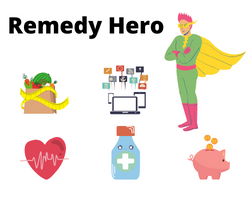Elimination Diet and Depression: Finding Relief Through Food Choices
Are you struggling with depression and wondering if your diet might be part of the problem? The idea of an elimination diet might seem overwhelming, but it could hold the key to improving your mood. An elimination diet can help pinpoint foods that might be exacerbating your depressive symptoms. Discovering which foods are affecting you negatively can lead to better mental health and overall well-being.
By following an elimination diet, you systematically remove certain foods from your diet and then gradually reintroduce them to see how your body and mind respond. This process can help identify food sensitivities that might be contributing to your emotional state. Many people have found relief from depressive symptoms by making these dietary adjustments.
Embarking on this journey takes careful planning and a bit of patience, but the potential rewards make it worth the effort. If you’re ready to explore the link between your diet and depression, this guide will walk you through everything you need to know to get started and succeed.
Key Takeaways
- Elimination diets can help identify food sensitivities affecting your mood.
- The process involves removing and gradually reintroducing certain foods.
- Careful planning and patience are essential for success.
- Elimination diets remain the gold standard in confirming food sensitivities (even when lab testing has been done) and figuring out your unique “dose tolerance” to individual foods.Source: lilynicholsrdn.com
What Is an Elimination Diet?
An elimination diet helps you identify foods that might be triggering negative symptoms or reactions. It involves removing certain foods and reintroducing them to pinpoint which ones cause issues.
Defining Elimination Diet
An elimination diet is a short-term eating plan. It involves removing foods that might be causing problems, like allergies or digestive issues. You follow this plan for a few weeks to see if symptoms improve.
After this phase, you slowly add the foods back into your diet, one at a time. You watch for any reactions when you reintroduce a food. This helps you figure out if a specific food is causing your symptoms. Sometimes, it takes a while to see the effects, so patience is key.
Common Foods Eliminated
During an elimination diet, you often cut out common allergens and irritants. These might include dairy, gluten, soy, and nuts. Some diets also avoid foods like eggs, corn, and certain fruits or vegetables.
Many elimination diets also exclude processed foods and sugars. This helps focus on natural, whole foods that are less likely to cause issues. For some, even caffeine and alcohol are removed during this time.
Eliminating these foods helps in tracking what impacts your body. Each food group can be added back in gradually to monitor for any adverse reactions, helping you spot what to avoid in the future.
Link Between Diet and Depression
Your diet can have a big impact on how you feel mentally. Eating certain foods might help reduce symptoms of depression, while other foods could make it worse.
Nutrition and Mental Health
What you eat influences your brain function and mood. Nutrients like omega-3 fatty acids, vitamins, and minerals play a crucial role in keeping your brain healthy.
You might find that a diet rich in fruits, vegetables, whole grains, and fish can help improve your mood. These foods provide important nutrients and antioxidants that support brain health.
On the flip side, an inflammatory diet high in processed foods, sugar, and unhealthy fats can increase the risk of depression. Chronic inflammation from poor nutrition can negatively affect your mental wellbeing.
Studies on Diet and Depression
Several studies show a connection between diet quality and depression. For example, a Harvard Health article highlights that eating more fruits, vegetables, whole grains, and fish can lower the risk of depression.
Another study found an inflammatory diet is linked to a higher risk of depression. This study used Reduced Rank Regression to show that chronic inflammation could be an underlying cause.
Further reviews and research analyses support the idea that your diet affects your risk of depression. For instance, one systematic review discovered that low-quality diets might hide a stronger link between diet and depression due to methodological shortcomings. Improving your diet quality could have positive public health impacts.
Planning Your Elimination Diet
Creating an effective elimination diet involves setting clear goals, seeking the right guidance, and keeping detailed records of your food intake and symptoms.
Setting Clear Goals
Start by identifying what you hope to achieve with the elimination diet. Some people aim to improve their mental health, while others focus on reducing physical symptoms like bloating or skin issues. Make a list of the specific symptoms you want to track. Define what success looks like for you.
For example, you might want to reduce the number of headaches you get each week. A clear goal makes it easier to measure progress and stay motivated. Also, decide how long you’re willing to follow the elimination phase, typically one to two months.
Consulting Professionals
Before starting, talk to a healthcare professional. They can give you advice tailored to your specific needs. This could be your primary care doctor, a registered dietitian, or even a mental health specialist if you’re focusing on depression. Professionals help identify which foods to eliminate.
Some common allergens to consider are dairy, gluten, and soy. They can also suggest healthy substitutes. This ensures you’re not missing out on essential nutrients. Regular check-ins with a professional can help make adjustments based on your progress or any new symptoms.
Creating a Food Diary
A food diary helps you keep track of what you eat and any symptoms you experience. Write down everything you consume, including meals, snacks, and even drinks. Be specific about quantities and ingredients used. Note the time of day you eat and any symptoms that occur afterward.
For instance:
| Date | Food | Symptoms | Time |
|---|---|---|---|
| August 15, 2024 | Chicken salad, apple | Headache, bloating | 1 PM |
This detailed record helps you see patterns and identify problem foods. Many people find it useful to review their diary with a professional during check-ins. This makes it easier to spot correlations and make necessary adjustments.
Executing the Elimination Phase
The elimination phase involves removing potential trigger foods from your diet. You’ll need to closely monitor your symptoms and may need to keep a food journal to track your progress.
Starting with Elimination
Begin by identifying and removing common trigger foods from your diet. These often include dairy, gluten, soy, eggs, nuts, and shellfish. Check labels of processed foods for hidden ingredients that might cause problems.
Stick to a simple meal plan featuring whole foods like fruits, vegetables, lean proteins, and gluten-free grains. Being strict during the initial phase is crucial. Commit to this phase for at least 2-4 weeks to give your body a chance to detox and reset.
Hydration is important, so drink plenty of water. Avoid caffeine and alcohol as they can interfere with the process. Consult a healthcare professional for personalized guidance.
Monitoring Symptoms
As you eliminate foods, keep a detailed record of your symptoms. A food journal is key. Note down what you eat, how much you eat, and any physical or emotional changes you experience.
Look for patterns. Are certain symptoms like headaches, digestive issues, or mood swings improving? This information helps pinpoint which foods might be causing issues.
You might also track non-food factors like sleep quality and stress levels. This gives a fuller picture of what might be affecting your mental health.
Share your findings with your healthcare provider. They can help you interpret your journal entries and decide what steps to take next. When ready, you’ll gradually reintroduce foods one by one to see which ones trigger symptoms.
Reintroduction and Testing Phase
In the reintroduction phase, you carefully add foods back into your diet and monitor your body’s responses. This helps identify trigger foods that may affect your mood or worsen depression symptoms.
Careful Reintroduction
When reintroducing foods, it’s important to go slowly and be methodical. Start by adding small portions of one new food at a time every 4-7 days. Begin with a small amount on the first day and gradually increase to a full serving by the third day. This way, you can easily spot any adverse reactions.
Keep a detailed food diary during this phase. Write down what you eat, when you eat it, and any symptoms you experience. This helps you see patterns and connections between specific foods and how you feel.
Make sure to reintroduce foods when you feel stable and calm. Avoid testing new foods during stressful times, as stress can affect your symptoms. If you notice any negative reactions, stop eating the food immediately and give yourself a few days to recover before trying the next one.
Identifying Triggers
Identifying trigger foods is crucial for maintaining mood stability. Common triggers may include gluten, dairy, sugar, and processed foods. By tracking your symptoms, you can pinpoint which foods tend to worsen your depression or make you feel off.
Pay close attention to physical symptoms like bloating, headaches, or fatigue. These can often accompany mood changes and help you identify problem foods. Use your food diary to keep a record of your observations and discuss them with a healthcare professional if needed.
Sometimes it’s helpful to re-test foods to confirm their effects. Wait a couple of months and try reintroducing the suspect food again to see if the reaction is consistent. This helps ensure that your findings are accurate and helps you make better dietary choices in the long run.
Long-Term Management
Managing long-term health with an elimination diet involves maintaining a balanced diet and considering lifestyle factors that influence both physical and mental well-being. Making these changes sustainable is key for ongoing success.
Maintaining a Balanced Diet
It’s important to ensure you’re getting all essential nutrients after removing certain foods from your diet. Focus on eating a variety of fruits, vegetables, lean proteins, and whole grains. These provide necessary vitamins and minerals.
Use a meal planner to keep track of what you’re eating. This helps you ensure balanced nutrition. You might also find it helpful to work with a nutritionist. They can guide you in replacing essential nutrients that may be lost due to the elimination diet.
Hydration is another key aspect. Drink plenty of water throughout the day. Avoiding processed foods and added sugars can also improve your mood and energy levels. Consistent nutrient intake aids in preventing deficiencies that could affect both physical health and emotional well-being.
Lifestyle Considerations
Your lifestyle choices can greatly influence how well you manage your diet and mental health. Regular exercise improves mood and reduces symptoms of depression. Even a 30-minute walk can make a difference.
Adequate sleep is crucial. Aim for 7-9 hours of quality sleep per night. Consistent sleep patterns help regulate mood and energy levels. Managing stress through mindfulness techniques, such as meditation or yoga, can also support both mental and physical health.
Social support is invaluable. Keep in touch with friends and family. Sharing your experiences with them can help you stay motivated. Online forums and support groups can also offer encouragement and practical tips for sticking to your lifestyle changes.
Potential Challenges and How to Overcome Them
Starting an Elimination Diet:
Kicking off an elimination diet can be tough. You might miss your favorite foods. To make it easier, plan your meals in advance and find tasty recipes that fit the guidelines.
Symptoms During Elimination:
You might feel tired or irritable as your body adjusts. Stay hydrated and get plenty of rest. Ensure you’re still eating a balanced diet with lots of vegetables, proteins, and healthy fats.
Reintroducing Foods:
It can be tricky to figure out which foods are causing problems. Reintroduce one food at a time and keep a journal. Write down any changes in mood or physical symptoms.
Social Situations:
Eating out or going to gatherings might be challenging. Inform your friends about your diet and suggest places that have options for you. Bring your own dish to share at social events.
Sticking to the Plan:
It’s easy to slip back into old habits. Keep reminding yourself why you started and track your progress. Celebrate small wins and do your best to stay committed.
Cost of Special Foods:
Buying specific items for your diet can sometimes be expensive. Look for sales, buy in bulk, and choose store brands when possible.
Cravings and Emotional Eating:
You might crave eliminated foods out of habit or emotional comfort. Find healthy alternatives that you enjoy and try to address emotional eating triggers through other means, like talking to a friend or going for a walk.
Success Stories and Personal Experiences
Finding an elimination diet that works for your depression can make a big difference in your life. Here are some inspiring stories from people who found success.
Maria shared her journey from severe depression to a brighter outlook. She emphasized that making a firm decision to address her depression was the first crucial step. Maria explored various resources and eventually discovered a long-term remedy that transformed her mood problems. You can read about her experience here.
Michael turned to fasting during a tough period. After four days without food, he felt a dramatic improvement in his mental health. His story of overcoming tough times and finding balance is both powerful and motivating. Learn more about Michael’s journey here.
The Low FODMAP Diet has also been helpful for some. In the first phase, you eliminate high FODMAP foods, which some people find beneficial. This diet can be challenging, but many have seen improvements in their mental well-being. More details on this diet can be found here.
Finally, a plant-based diet has made a world of difference for Karen. She struggled with depression and weight issues for decades. Cutting dairy from her diet helped her feel healthy and happy again. Find out more about Karen’s uplifting experience here.
If you’re considering an elimination diet, these stories show that there’s hope, and you might find something that works for you too.
Frequently Asked Questions
Changing your diet can have a significant impact on your mood and mental health. Here, we’ll cover common questions about how an elimination diet might affect your well-being.
How might changing my eating habits affect my mood?
When you adjust your diet, you’re not just feeding your body but also your brain. Foods rich in nutrients like omega-3 fatty acids, vitamins, and minerals can help balance your mood. Removing potentially inflammatory foods can improve your mental clarity and energy levels.
What mental side effects might I experience on an elimination diet?
At first, you might feel irritable or fatigued as your body adjusts to the new diet. These symptoms usually subside after a few days. Some people report feeling less brain fog and more mental clarity after eliminating certain foods.
Which foods are commonly eliminated first when trying to improve mental well-being?
Foods often eliminated first include gluten, dairy, sugar, caffeine, and alcohol. These are known to potentially contribute to inflammation and mood swings. By cutting them out, you can see if they are affecting your mental health.
Could an elimination diet potentially improve anxiety symptoms?
Yes, an elimination diet can help you identify foods that might be triggering anxiety. By pinpointing and removing these foods, you might experience a reduction in anxiety symptoms. Foods like sugar and caffeine are common culprits.
Are there any individuals who should avoid following an elimination diet?
People with certain medical conditions, like diabetes or eating disorders, should consult a healthcare provider before starting an elimination diet. Pregnant women and children should also get professional advice to ensure they meet their nutritional needs.
What’s the connection between exercise, diet, and overall mental health?
Exercise releases endorphins that boost your mood, and a balanced diet supports brain health. Combining regular exercise with a nutritious diet can significantly improve your mental well-being. Nutrient-dense foods and physical activity work together to enhance your overall mental health.




